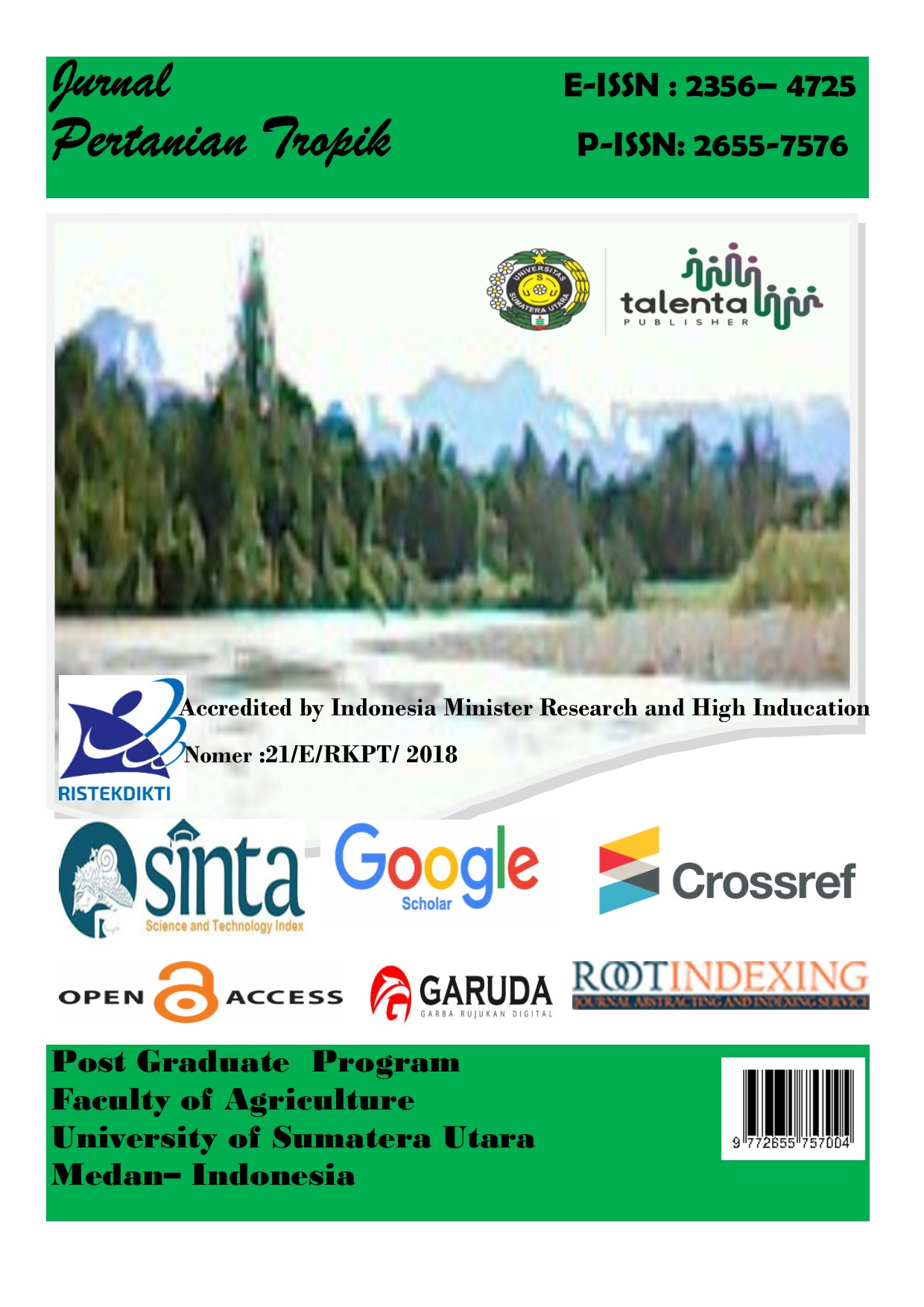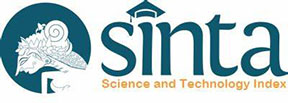Endophytic Fungi Producing Indole Acetic Acid from Melastoma malabathricum L. and Rhodomyrtus tomentosa (Aiton) Hassk. In Indonesia
DOI:
https://doi.org/10.32734/jopt.v7i2.4316Keywords:
Melastoma malabathricum L., Rhodomyrtus tomentosa (Aiton) Hassk.,Endophytic Fungi, Divesity, IAA, Seeds Germination.Abstract
Melastoma and Rhodomyrtus are known to have widespread distribution and considered as medicinal plants in Indonesia. However, information about the diversity of endophytic fungi in Melastoma malabathricum (MM) and Rhodomyrtus tomentosa (RT) is limited and their potential as an alternative source of indole acetic acid (IAA) has never been reported before. The purpose of this study was to determine the diversity of endophytic fungi from MM and RT which have the potential as an alternative source of IAA and potentially induce the germination of Capsicum annuum L. seeds. The research consisted of isolation of endophytic fungi, IAA production analysis, and capsicum seed germination test. Samples of MM and RT were obtained from Kelubi, East Belitung, Indonesia on August 7th, 2017. Endophytic fungi were isolated from various organs including : leaves, roots, stems, flowers, and fruits using surface sterilization method on the Malt Extract Agar (MEA). After purification, a total of 33 fungi were obtained (15 isolates from MM and 18 isolates from RT). Each endophytic colony shows unique and varied colony on a PDA medium. 17 endophytic fungal isolates in this study tested positive for IAA production. All strains produced different levels of IAA, where MIVA2, MIVD1, and MIVA3 had the highest levels of IAA concentrations (89 ppm, 82 ppm, and 70 ppm respectively). In the term of germination, there were 5 isolates which have high potential in inducing Capsicum annuum L. seeds, namely; MIVA3, MIVF3, RIVD2, RIVD5, RIVD6, RIVD9 (90%, 95%, 100%, 90%, 100%, 90%, respectively).
Downloads
References
Aly, A. H., Debbab, A., Kjer, J., & Proksch, P. 2010. Fungal endophytes from higher plants: a prolific source of phytochemicals and other bioactive natural products. Fungal Diversity, 41(1),1-16.
Arnold, A. E., & Lutzoni, F. 2007. Diversity and host range of foliar fungal endophytes: are tropical leaves biodiversity hotspots?. Ecology, 88(3), 541-549.
Gamalero, E., Lingua, G., Berta, G., & Glick, B. R. 2009. Beneficial role of plant growth promoting bacteria and arbuscular mycorrhizal fungi on plant responses to heavy metal stress. Canadian Journal of Microbiology, 55(5), 501-514.
Glienke-Blanco, C., Aguilar-Vildoso, C. I., Vieira, M. L. C., Barroso, P. A. V., & Azevedo, J. L. 2002. Genetic variability in the endophytic fungus Guignardia citricarpa isolated from citrus plants. Genetics and Molecular Biology, 25(2), 251-255. Gordon, S. A., & Weber, R. P. 1951. Colorimetric estimation of indoleacetic acid. Plant physiology, 26(1), 192.
Hasan, H. A. H. 2011. Gibberellin and auxin production by plant root-fungi and their biosynthesis under salinity-calcium interaction.Plant, Soil and Environment, 48(3), 101-106.
Hoffman, M. T., Gunatilaka, M. K., Wijeratne, K., Gunatilaka, L., & Arnold, A. E. 2013.Endohyphal Bacterium Enhances Production of Indole-3-Acetic Acid by a Foliar Fungal Endophyte. PLoS ONE, 8(9), e73132.
Jeenkeawpieam, J., Phongpaichit, S., Rukachaisirikul, V., & Sakayaroj, J. 2012. Antifungal activity and molecular identification of endophytic fungi from the angiosperm Rhodomyrtus tomentosa. African Journal of Biotechnology, 11(75), 14007-14016.
Khan, A. R., Ullah, I., Waqas, M., Shahzad, R., Hong, S. J., Park, G. S., & Shin, J. H. 2015. Plant growth-promoting potential of endophytic fungi isolated from Solanum nigrum leaves. World Journal of Microbiology and Biotechnology, 31(9),1461-1466.
Koornneef, M., Bentsink, L., & Hilhorst, H.2002. Seed dormancy and germination. Current opinion in plant biology, 5(1), 33-36.
Maynard, D. N., & Hochmuth, G. J. 1997. Knott's handbook for vegetable growers (No. Ed. 4). John Wiley and Sons, Inc.
Melnick, R. L., Suárez, C., Bailey, B. A., & Backman, P. A. 2011. Isolation of endophytic endospore-forming bacteria from Theobroma cacao as potential biological control agents of cacao diseases. Biological Control, 57(3), 236-245.
Meyer, K.2001. Revision of the Southeast Asian genus Melastoma (Melastomataceae).Blumea: Journal of Plant Taxonomy and Plant Geography. 46. 351-398.
Mishra, Y., Singh, A., Batra, A., & Sharma, M. M. 2014. Understanding the biodiversity and biological applications of endophytic fungi: a review. J. Microbiol. Biochem. Technol. S, 8.
Ngieng, N. S., Zulkharnain, A., Roslan, H. A., & Husaini, A. 2013. Decolourisation of synthetic dyes by endophytic fungal flora isolated from senduduk plant (Melastoma malabathricum). ISRN biotechnology, 1-7.
Octavianti, R., harahap, I., & Elsie, E. 2017. Isolation of Fungal Endophytes from Melastoma malabathricum L. and Their Potential as Antifungal. BIO-SITE, Biologi Dan Sains Terapan, 3(1), 19-24.
Okane, I., Toyama, K., Nakagiri, A., Suzuki, K. I., Srikitikulchai, P., Sivichai, S., ... & Læssøe, T. 2008. Study of endophytic Xylariaceae in Thailand: diversity and taxonomy inferred from rDNA sequence analyses with saprobes forming fruit bodies in the field. Mycoscience, 49(6), 359-372.
Panggabean, M.T., Amanah, S. & Tjitropranoto, P. 2016. Persepsi Petani Lada terhadap Diseminasi Teknologi Usahatani Lada di Bangka Belitung. Jurnal Penyuluhan, 12 (1): 61-73.
Putra, I. P., Rahayu, G., & Hidayat, I. 2015. Impact of domestication on the endophytic fungal diversity associated with wild Zingiberaceae at Mount Halimun Salak National Park. HAYATI Journal of Biosciences, 22(4), 157-162.
Radhakrishnan, R., Khan, A. L., Kang, S. M., & Lee, I. J. 2015. A comparative study of phosphate solubilization and the host plant growth promotion ability of Fusarium verticillioides RK01 and Humicola sp. KNU01 under salt stress. Annals of microbiology, 65(1), 585-593.
Rim, S. O., Lee, J. H., Khan, S. A., Lee, I. J., Rhee, I. K., Lee, K. S., & Kim, J. G. 2007. Isolation and identification of fungal strains producing gibberellins from the root of plants. Microbiology and Biotechnology Letters, 35(4), 357-363.
Rodriguez, R. J., White Jr, J. F., Arnold, A. E., & Redman, A. R. A. 2009. Fungal endophytes: diversity and functional roles. New phytologist, 182(2), 314-330.
Sarbadhikary, S. B., Pal, B., & Mandal, N. C.2016. Antimicrobial and antioxidant activities of two endophytic fungi isolated from Melastoma malabathricum L. leaves. Int J Curr Pharm Res, 8(3), 88-92. ISSN- 0975-7066
Schulz, B., & Boyle, C. 2005. The endophyte continuum. Mycological Research. 109(6): 661-686.
Strobel, G., & Daisy, B. 2003. Bioprospecting for microbial endophytes and their natural products. Microbiol. Mol. Biol. Rev., 67(4), 491-502.
Subash, M., Rafath, H., & Lalitha, J. 2014. Influence of GA3 and IAA and their Frequency of Application on Seed Germination and Seedling Quality Characters. International Letters of Natural Sciences, 30, 44–48.
Waqas, M., Khan, A. L., Kamran, M., Hamayun, M., Kang, S. M., Kim, Y. H., & Lee, I. J. 2012. Endophytic fungi produce gibberellins and indoleacetic acid and promotes host-plant growth during stress. Molecules, 17(9), 10754-10773.
Wilia, W., Widodo, Wiyono, S. 2013. Exploration of Endophytic Fungi from Pepper as Biological Control Agents of Anthracnose (Colletotrichum acutatum L.). Bioplantae, 2(1), 9-15.
Winotai, A., Wright, T., & Goolsby, J. A. 2005. Herbivores in Thailand on Rhodomyrtus tomentosa (Myrtaceae), an invasive weed in Florida. Florida Entomologist, 88(1), 104-106.
Yuan, Z. L., Lin, F. C., Zhang, C. L., & Kubicek, C. P. 2010. A new species of Harpophora (Magnaporthaceae) recovered from healthy wild rice (Oryza granulata) roots, representing a novel member of a beneficial dark septate endophyte. FEMS microbiology letters, 307(1), 94-101.
Zia, S., & Khan, M. A. 2004. Effect of light, salinity, and temperature on seed germination of Limonium stocksii. Canadian Journal of Botany, 82(2), 151-157.
Downloads
Published
How to Cite
Issue
Section
License
Copyright (c) 2020 Jurnal Pertanian Tropik

This work is licensed under a Creative Commons Attribution-ShareAlike 4.0 International License.






















